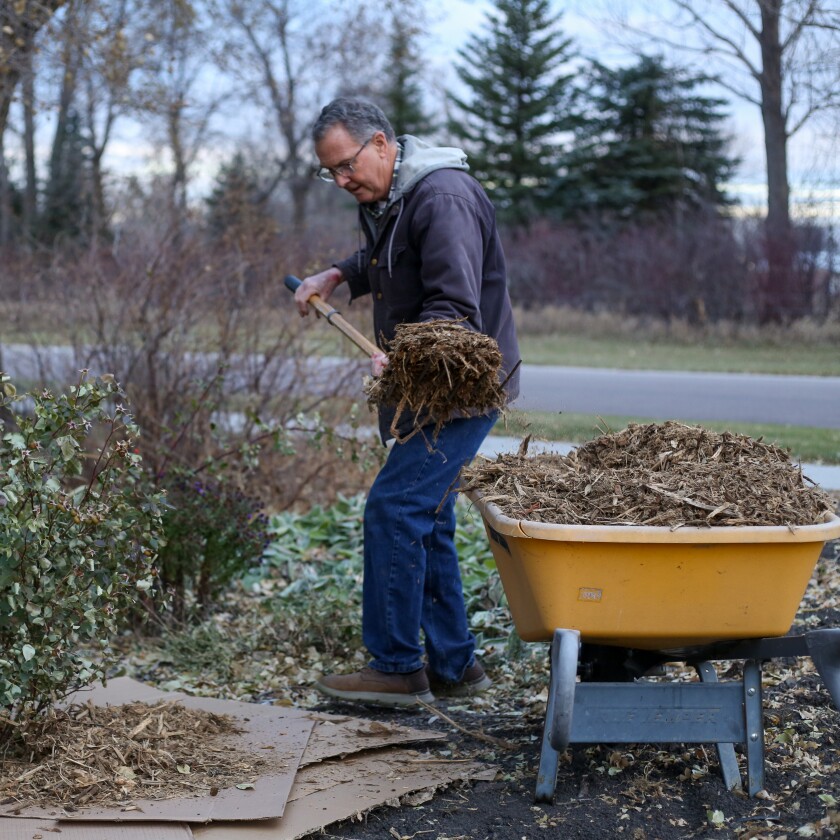Did you hear about Cuba’s struggle to control weeds? It’s being called the Cuban Thistle Crisis.
Whether it’s thistles or other annoying weeds, I’ve been controlling the invaders in our landscape and perennial flower gardens with shredded wood mulch with a rather surprising material underneath.
Before I reveal the secret ingredient that increases wood mulch’s weed-fighting power, let’s take a step back in time.
When my wife, Mary, and I operated our garden center business, we also provided landscape installation. The norm in the ’70s and ’80s was rock mulch installed over a layer of black plastic.
Rock, of course, is a long-lived product, but plastic proved to be problematic. Plastic doesn’t breathe, and soil underneath easily became hard-packed, moldy-moist and devoid of oxygen. Tree and shrub roots remained shallow, gasping for air.

Following those decades, newer plant-friendly products were developed. Woven landscape fabric became the norm, allowing better oxygen exchange with the soil.
With landscape fabric serving as the underlayment, rock mulch remains the most commonly used material to cover soil in shrub landscapes surrounding homes and commercial buildings. Most shrubs grow beautifully this way, although rock mulch isn’t immune to weed invasion.
Some perennials also grow fine in rock mulch, but it’s not their favorite home. Not many perennials in their native habitat have their soil covered in rocks, except in desert climates.
Perennial growth can be inhibited by rock mulch’s heavy weight, soil compaction, and heat retention. That’s why wood mulch is a plant-friendly alternative, not only for perennial gardens, but also for shrub-type landscapes.
Secret ingredient for use with wood mulch
A commonly used underlayment for wood mulch is landscape fabric. Oxygen exchange with soil is excellent, and the fabric is long-lived. Weeds can establish and grow when fabric is used, though, so it’s not entirely weed-proof, and the fabric isn’t a natural product.
Wood mulch can be installed directly on the soil surface without any underlayment, but weeds can easily poke through. Underlayments, although not perfect, add teeth to weed control.
My secret ingredient underlayment, which I prefer over landscape fabric in my own situations, including perennial beds and shrub landscapes, is simply cardboard.

Brown corrugated cardboard make an effective underlayment for wood mulch.
Chris Flynn / The Forum
Weeds are opportunists, and even the slightest ray of light is a personal invitation. Cardboard shuts down the invitation, and unlike plastic or landscape fabric, cardboard breaks down after about three growing seasons into organic matter, becoming part of the soil, and in the meantime, smothers weeds.
Placing cardboard under 3 inches or more of mulch creates a layered defense. The mulch blocks the sun from above, while cardboard blocks the weeds from below. Meanwhile, moisture moves through, and beneficial soil organisms thrive in cardboard’s natural environment.
In perennial gardens, cardboard offers greater flexibility in digging, dividing and planting than a fabric underlayment provides. Cardboard is easy to cut, replace and reposition as perennial plantings change.

Tape or other plastic should be removed from cardboard.
Chris Flynn / The Forum
Finding the right cardboard
This is one time online shopping can benefit your yard. Plain brown corrugated cardboard from shipping boxes is ideal, but remove the tape before using. Don’t use cardboard that is coated with glossy material or printed with colored inks.
Flatten the boxes, cutting very large sheets into smaller usable sections.
Prepare the area by knocking down any tall weeds or grass. There’s no need to till; the cardboard does the smothering for you.
Lay the cardboard on the surface, overlapping edges generously, at least 6 inches or more. If seams aren’t overlapped enough, weeds will find their way through the gaps. Make sure the edges of the cardboard reach right up to plant bases, fence lines or bed edging.

Overlap seams generously to prevent weed growth.
Chris Flynn / The Forum
Cover the cardboard underlayment with 3 to 5 inches of mulch, which can be leaves, compost or wood products. I favor shredded wood mulch, which meshes together better than wood chips, in my experience, creating a tighter mulch that doesn’t blow or float away in wind and rain.
Shredded wood mulch can be purchased from tree removal companies that have the equipment needed to grind and shred branches and logs into mulch consistency, rather than chipping the material. Wood chips can work well, too, although I feel shredded mulch meshes together better.

Shredded wood mulch can be purchased from some tree removal companies.
Chris Flynn / The Forum
Good for new beds or established areas
If you intend to use cardboard and mulch in a new planting, it’s easiest to install the plants first and then apply the mulch after planting. In established beds, cardboard plus mulch can reclaim areas where quackgrass, thistles and other perennial weeds have invaded, by smothering them.
Cardboard can also be laid directly over lawn grass and covered with mulch, creating protective circles around trees planted in turf.
While any mulch won’t solve every weed battle, it does shift the odds in our favor.


Comments are closed.